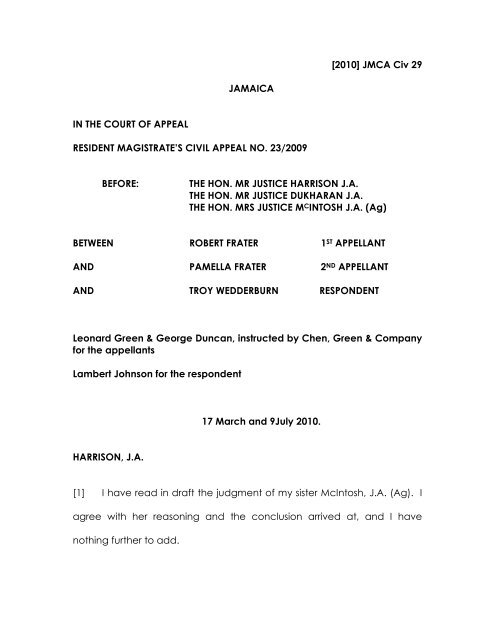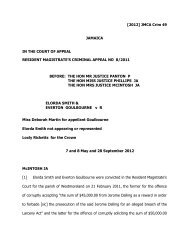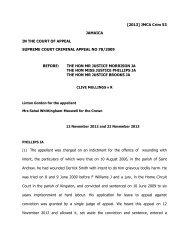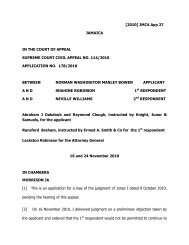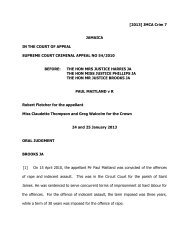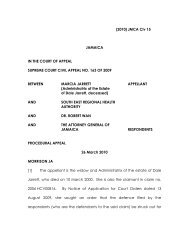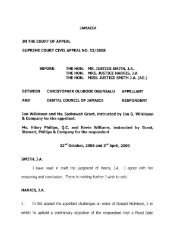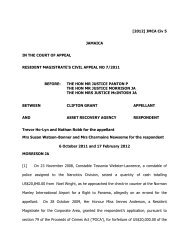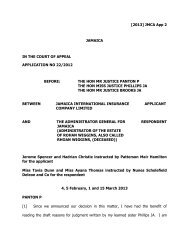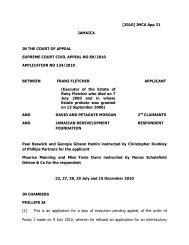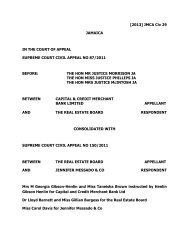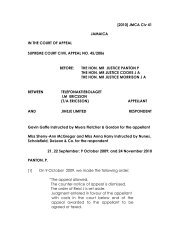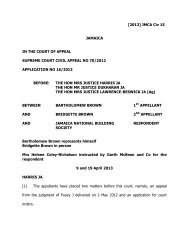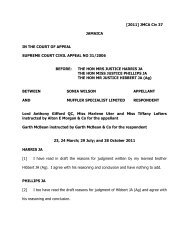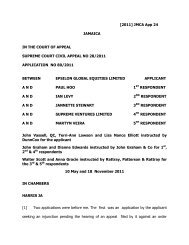Frater (Pamella) v Wedderburn - The Court of Appeal
Frater (Pamella) v Wedderburn - The Court of Appeal
Frater (Pamella) v Wedderburn - The Court of Appeal
You also want an ePaper? Increase the reach of your titles
YUMPU automatically turns print PDFs into web optimized ePapers that Google loves.
IN THE COURT OF APPEAL<br />
JAMAICA<br />
RESIDENT MAGISTRATE’S CIVIL APPEAL NO. 23/2009<br />
[2010] JMCA Civ 29<br />
BEFORE: THE HON. MR JUSTICE HARRISON J.A.<br />
THE HON. MR JUSTICE DUKHARAN J.A.<br />
THE HON. MRS JUSTICE M CINTOSH J.A. (Ag)<br />
BETWEEN ROBERT FRATER 1 ST APPELLANT<br />
AND PAMELLA FRATER 2 ND APPELLANT<br />
AND TROY WEDDERBURN RESPONDENT<br />
Leonard Green & George Duncan, instructed by Chen, Green & Company<br />
for the appellants<br />
Lambert Johnson for the respondent<br />
HARRISON, J.A.<br />
17 March and 9July 2010.<br />
[1] I have read in draft the judgment <strong>of</strong> my sister McIntosh, J.A. (Ag). I<br />
agree with her reasoning and the conclusion arrived at, and I have<br />
nothing further to add.
DUKHARAN, J.A.<br />
[2] I too agree with the reasoning and conclusion <strong>of</strong> my sister McIntosh,<br />
J.A. (Ag), and have nothing to add.<br />
M CINTOSH, J. A. (Ag)<br />
Introduction<br />
[3] <strong>The</strong> respondent is the occupant <strong>of</strong> most <strong>of</strong> the first floor <strong>of</strong> a two<br />
storey commercial building situated at 6 Saint James Street, Montego Bay,<br />
in the parish <strong>of</strong> Saint James. He became a tenant <strong>of</strong> the appellants’<br />
father, Mr Clive <strong>Frater</strong>, who, according to his evidence, entered into a ten<br />
year lease agreement with him, commencing on 9 August 2004.<br />
However, on the death <strong>of</strong> Mr <strong>Frater</strong>, the appellants assumed control over<br />
the premises, as beneficiaries, with no apparent knowledge <strong>of</strong> the<br />
existence <strong>of</strong> the lease agreement. <strong>The</strong> respondent thereafter paid rent to<br />
the appellants and continued to operate three businesses on the<br />
premises, namely, a bar, a tavern which includes rooms “rented on a short<br />
term basis or for the whole night”, and a record shop.<br />
[4] On 22 July 2008, the appellants served a notice to quit on the<br />
respondent, requiring him to quit and deliver up possession <strong>of</strong> the premises<br />
“on the 31 st <strong>of</strong> August, 2008 or on such day as your tenancy shall next
expire after one (1) month from the date here<strong>of</strong>”. <strong>The</strong> reason given for<br />
the notice was that the “premises requires urgent structural repairs”. After<br />
the expiration <strong>of</strong> the notice period, the respondent remained in possession<br />
and the appellants then made a claim for recovery <strong>of</strong> possession <strong>of</strong> the<br />
premises, in the Resident Magistrate’s <strong>Court</strong> for the parish <strong>of</strong> Saint James.<br />
[5] <strong>The</strong> particulars <strong>of</strong> claim filed in the action states simply that:<br />
“<strong>The</strong> Plaintiff claims to recover from the<br />
Defendant possession <strong>of</strong> premises situated at<br />
Shop 3 and 4, 2 nd Floor, 6 Saint James, Montego<br />
Bay, Saint James, upon whom Notice to Quit in<br />
writing has been served and inspite (sic) there<strong>of</strong>,<br />
the defendant has failed to quit and vacate the<br />
said premises.”<br />
[6] <strong>The</strong> respondent’s defence was equally simple and brief stating that:<br />
“<strong>The</strong> Defendant has a ten (10) year lease and<br />
only four (4) years on that lease has (sic) gone so<br />
far. Additionally, the reason given for the notice<br />
– the premises need urgent structural repairs – is<br />
an invalid one. <strong>The</strong> building is not in need <strong>of</strong> any<br />
urgent repair that would necessitate my client’s<br />
removal from the premises.”<br />
[7] <strong>The</strong> trial commenced before Her Honour, Mrs V. Harris, acting Senior<br />
Resident Magistrate for the parish, on 27 January 2009 and concluded on<br />
24 July 2009, when judgment was given to the respondent with costs <strong>of</strong><br />
$15,001.00. <strong>The</strong> learned Resident Magistrate also ordered the respondent<br />
to repair, at his own expense, faulty floor boards detected on the<br />
premises occupied by him and further ordered that repairs which were to
e done to the ro<strong>of</strong> and the wall <strong>of</strong> the premises be done in such a way<br />
that the defendant’s business operations were minimally affected. This<br />
decision is the subject <strong>of</strong> the appeal now before the court.<br />
<strong>The</strong> Evidence<br />
[8] <strong>The</strong> second appellant, Miss <strong>Pamella</strong> <strong>Frater</strong>, gave evidence on their<br />
behalf. She described the building as very old and in bad condition with<br />
a large open crack in the wall and a tree growing on a ledge to the front<br />
<strong>of</strong> the building. It was her opinion that if the crack should break, that<br />
section <strong>of</strong> the building would hit the road. <strong>The</strong> first floor ceiling is falling out<br />
and the tenants on the ground floor have been complaining that the<br />
ceiling is leaking. She had served the notice to quit on the respondent so<br />
that “I can repair the section that the defendant is in”. She said she plans<br />
to replace the ro<strong>of</strong> first then the flooring <strong>of</strong> the first floor and to demolish<br />
and rebuild the section <strong>of</strong> the building occupied by the respondent.<br />
[9] In cross examination Miss <strong>Frater</strong> stated that other tenants had not<br />
been given notices to quit. It was her evidence that at one point the<br />
ground floor tenants had been given notice because the rent was<br />
increased and they did not want to pay the increase (but it appears that<br />
their attitude must have changed as they are still in occupation). She said<br />
the respondent pays his rent and is an “OK tenant” but when the place is<br />
repaired she does not intend to rent for “that sort <strong>of</strong> business anymore”
though she denied knowing that he rents rooms on short term bases to<br />
men and women and that his business is operated at nights. <strong>The</strong> repairs<br />
would be done in the day, she said.<br />
[10] Not only was she unaware <strong>of</strong> the existence <strong>of</strong> the lease but when it<br />
was produced and shown to her, she challenged the signature purported<br />
to be that <strong>of</strong> her father. She had no knowledge that the respondent had<br />
given money to her father to repair the ro<strong>of</strong> and that the repairs had<br />
been done.<br />
[11] <strong>The</strong>ir witness, Mr Jason Jemmison, described himself as a building<br />
contractor. He testified that he went to the building at the request <strong>of</strong> the<br />
second appellant and had given her an estimate for refurbishing and<br />
reconstructing the building. He had made the following observations:<br />
i) a crack to the side <strong>of</strong> the building which needs<br />
to be cut out and a column put in;<br />
ii) the ceiling needs to be changed in that “the<br />
boards are opening up and falling apart.<br />
Maybe the laths behind it are damaged. I am<br />
not able to say”;<br />
iii) the flooring boards need to be changed “as<br />
they are getting s<strong>of</strong>t. Whenever you step on<br />
them they feel as if they are sinking”;<br />
iv) the rafters that make the ro<strong>of</strong> need changing as<br />
they are rotting.
[12] He said that the work which has to be done will affect persons<br />
downstairs as well and nothing can be done while the building is<br />
occupied. In cross examination he said that the work could take from<br />
three weeks to one month. He had no information that the ro<strong>of</strong> was<br />
leaking. He had gone on top <strong>of</strong> the ro<strong>of</strong> to take some measurements but<br />
he did not know if the ro<strong>of</strong> was bad or if in its present condition, it can last<br />
a few more years. He testified that the strength <strong>of</strong> the building is in the<br />
corner where the building is joined. He could not say if the crack at the<br />
side was there for a very long time. He had observed it in June/July 2008<br />
and saw it again about some six/eight months later, (January/February,<br />
2009) at which time it appeared to him that the crack had gotten bigger.<br />
Mr. Jemmison said that the owners <strong>of</strong> the building had requested that the<br />
floor and the ro<strong>of</strong> be replaced and those were “structured repairs”.<br />
[13] At the conclusion <strong>of</strong> his cross examination the court felt moved to<br />
seek some clarification <strong>of</strong> his evidence on the condition <strong>of</strong> the ro<strong>of</strong> and<br />
floor, no doubt because these were the areas said to require “structured<br />
repairs”. However, Mr Jemmison was not able to provide the clarification<br />
sought as he said he could not give any definite answer on the condition<br />
<strong>of</strong> the ro<strong>of</strong> or the floor as he had not inspected them. <strong>The</strong> ro<strong>of</strong> could be<br />
inspected with the tenant in occupation but not the floor. He said “Based<br />
on what I saw <strong>of</strong> the ceiling and the floor, they are leaking”. He added<br />
that it was his opinion that the building was not safe as it was falling apart.
[14] <strong>The</strong> respondent, Mr Troy <strong>Wedderburn</strong>, testified that he knew the<br />
building since 1983 and has been a tenant there since 2002, first<br />
downstairs and then upstairs. He was given possession <strong>of</strong> the upstairs<br />
section <strong>of</strong> the premises in 2003 but took up occupation in 2004 as it was in<br />
a terrible condition inside and needed to be repaired. He had not<br />
actually done the repairs himself but had given money to Mr <strong>Frater</strong> for the<br />
repairs to be done. <strong>The</strong> bathroom fixtures were gone and he had to<br />
replace them and he also reinforced the floor. Some painting was also<br />
done. <strong>The</strong> zinc was bad and the ro<strong>of</strong> was leaking and he had re-zinced<br />
the entire ro<strong>of</strong>. All <strong>of</strong> this was done in 2004.<br />
[15] In cross examination he said he had complained about fixing the<br />
building at his expense and, after he gave Mr <strong>Frater</strong> sixty thousand dollars<br />
($60,000.00) to fix the ro<strong>of</strong>, Mr <strong>Frater</strong> agreed to give him and subsequently<br />
did give him a lease for ten years. <strong>The</strong>y both signed the lease in August<br />
2004, in the presence <strong>of</strong> another man, although this man did not sign as<br />
witness to their signatures. When he first saw the document there was<br />
already a signature on it. He did not tell the appellants about the lease<br />
when he got the notice because he did not get a chance to talk to them.<br />
[16] According to the terms <strong>of</strong> the lease, which has another six years to<br />
run, he is responsible for repairs to the interior <strong>of</strong> the premises and he will<br />
repair the sections <strong>of</strong> the floor that are sinking. He said that there are two
cracks to the sides <strong>of</strong> the building; that “the crack” was there since 1980<br />
(although it is not clear how he was able to say this since he did not know<br />
the building until three years later) and that it has not gotten worse since<br />
he first saw it. It was also his evidence that he has had no problem with<br />
the ro<strong>of</strong> since he repaired it and it has survived two hurricanes.<br />
[17] Mr <strong>Wedderburn</strong> told the court that he could remain in the building<br />
and continue to conduct his business if the repairs to the ro<strong>of</strong> and the<br />
flooring were done in parts. If repairs were to be done to the wall, only<br />
the bar would be affected. His other business operations could continue.<br />
[18] His witness, Mr Rupert Irving, declared himself to know every corner<br />
and crevice <strong>of</strong> the building as he had lived there for a number <strong>of</strong> years.<br />
He had been brought there to live, rent free, by Mr Clive <strong>Frater</strong> whom he<br />
had known for over thirty years.<br />
[19] He knew the crack to the left side <strong>of</strong> the building for at least 28<br />
years. He had painted the building about two years after he moved there<br />
and the crack was there then. It had not gotten any bigger. He knew all<br />
about Mr <strong>Frater</strong>’s business and knew that after a while, a lease was drawn<br />
up with the respondent. That was not at the same time that the place was<br />
rented to the respondent but after the place was repaired and painted.
Summary <strong>of</strong> the Learned Resident Magistrate’s Findings<br />
[20] It is sufficient for the purpose <strong>of</strong> this appeal to confine this summary<br />
<strong>of</strong> the learned Resident Magistrate’s findings to those areas to which the<br />
court’s attention was particularly drawn.<br />
[21] After outlining the defects which the appellants described and the<br />
possible remedial action to be taken, the learned Resident Magistrate<br />
found that no evidence was given as to how urgently all the intended<br />
repairs were required and the reasons, if any, for the urgency.<br />
[22] She looked at the contrasting contentions <strong>of</strong> the appellants and the<br />
respondent, the former contending that “to thoroughly inspect and repair<br />
the floor and the ro<strong>of</strong> <strong>of</strong> the building as well as to repair the crack in the<br />
wall the defendant who occupies the upper floor <strong>of</strong> the building could<br />
not remain in possession/occupation” and the latter contending that the<br />
repairs to the wall, the ro<strong>of</strong> and the floor could be done in such a way as<br />
to allow him to remain in occupation.<br />
[23] <strong>The</strong>n the learned Resident Magistrate referred to the evidence <strong>of</strong> Mr.<br />
Irving, outlining its effect as follows:<br />
“1. <strong>The</strong> crack up to now has not affected the integrity <strong>of</strong> the<br />
building and as a result did not pose any danger to the<br />
occupants or third parties.
2. <strong>The</strong> ro<strong>of</strong> was repaired in 2004, it does not leak and neither<br />
was it in as bad a shape as the plaintiffs are making it out to<br />
be.<br />
3. <strong>The</strong> lease was authentic.”<br />
[24] <strong>The</strong> third effect, the learned Resident Magistrate said, was <strong>of</strong> some<br />
importance as the second appellant’s evidence was that she did not<br />
recognize the signature on the lease agreement as being her father’s.<br />
She also noted the indications from the second appellant that, after the<br />
building was repaired and refurbished, she would not be renting any part<br />
<strong>of</strong> it as a tavern.<br />
<strong>The</strong> Issue Identified by the Resident Magistrate<br />
[25] <strong>The</strong> learned Resident Magistrate identified the authenticity <strong>of</strong> the<br />
lease as the main issue to be determined. She stated that the question <strong>of</strong><br />
the genuineness <strong>of</strong> the lease was a question <strong>of</strong> fact and if it was found to<br />
be valid, the appellants, as beneficiaries <strong>of</strong> their father’s estate, were<br />
bound by its terms.<br />
[26] She questioned whether a lease such as in the instant case (for a<br />
term <strong>of</strong> ten years) could be terminated by a notice to quit under section<br />
25 <strong>of</strong> the Rent Restriction Act (the Act). If the answer was in the<br />
affirmative, she said, then the court would need to address the
genuineness <strong>of</strong> the reason given for the notice and determine where the<br />
greater hardship would lie.<br />
[27] However, she expressed doubt as to the genuineness <strong>of</strong> the reason<br />
given, especially in circumstances where the respondent seemed to have<br />
been singled out for notice and the rent <strong>of</strong> the other tenants, without<br />
notice, had been significantly increased as compared to his low rent.<br />
[28] She found on the evidence and on a balance <strong>of</strong> probabilities that<br />
the lease was valid and stated that it could only be terminated before the<br />
end <strong>of</strong> the term “if the tenant has been in breach <strong>of</strong> a condition in the<br />
lease, or the lease contains a forfeiture clause and the tenant has<br />
committed a breach <strong>of</strong> covenant which entitles the landlord to forfeit the<br />
lease.” She found that this lease contained no forfeiture clause.<br />
[29] <strong>The</strong> learned Resident Magistrate considered clause one <strong>of</strong> the lease<br />
which states that:<br />
“In consideration <strong>of</strong> the lease the Landlord<br />
hereby agrees to lease the tenant rooms and bar<br />
for a period <strong>of</strong> ten (10) years effective August 9,<br />
2004 in which repairs and interior works will be<br />
done at tenant’s expense.”<br />
In her judgment, the respondent was obligated to carry out repairs and<br />
interior works at his own expense, by virtue <strong>of</strong> this clause. <strong>The</strong> respondent<br />
would be required not only to keep the premises in good order and<br />
condition, she said, but also to ensure that the premises were kept in a
tenantable state <strong>of</strong> repair and that reasonable standards <strong>of</strong> maintenance<br />
were also observed.<br />
[30] She found that the appellants had brought no evidence which<br />
satisfied her that they were entitled to forfeit the lease. She then<br />
summarized her findings in this way:<br />
“I find on a balance <strong>of</strong> probabilities that the<br />
defendant holds a valid lease for the first floor <strong>of</strong><br />
the premises for a fixed period <strong>of</strong> ten (10) years<br />
and the plaintiffs are bound by this lease.<br />
Further, no evidence has been elicited to show<br />
that the plaintiffs can forfeit the lease because<br />
the defendant has breached the condition <strong>of</strong><br />
the lease which obligates him to carry out repairs<br />
and interior works at his expense. <strong>The</strong> plaintiff’s<br />
claim therefore fails.”<br />
[31] She further found that the building was not in need <strong>of</strong> urgent<br />
structural repairs and it was her view that this action was an attempt to<br />
dispossess a tenant who enjoys the protection <strong>of</strong> a lease which favours<br />
him with a relatively low monthly rent.<br />
<strong>The</strong> Arguments on <strong>Appeal</strong><br />
[32] <strong>The</strong> appellants’ argument is posited as follows:<br />
(a) <strong>The</strong> findings <strong>of</strong> the learned Resident Magistrate are confusing<br />
and inconsistent in that she seemed to have viewed the case<br />
entirely in terms <strong>of</strong> the genuineness <strong>of</strong> the lease, yet made<br />
findings on issues relating to whether the appellants had<br />
adduced satisfactory evidence entitling them to forfeit the<br />
lease for breach <strong>of</strong> the respondent’s obligation to repair as a<br />
result <strong>of</strong> which “immediate remedial action was required if<br />
the building was not to suffer irreparable damage”.
(b) Having found that:<br />
(i) a landlord can terminate for breach <strong>of</strong> a covenant to<br />
repair;<br />
(ii) the building was in need <strong>of</strong> repair;<br />
(see orders 2 and 3 <strong>of</strong> her findings at page 9) and<br />
(iii) the respondent was obligated to repair pursuant to the<br />
condition in the lease;<br />
she failed to draw the unavoidable inference that the<br />
respondent was in breach <strong>of</strong> his duty to keep the premises in<br />
good and tenantable repair.<br />
[33] It was submitted that the respondent would also be in breach <strong>of</strong><br />
section 95 <strong>of</strong> the Registration <strong>of</strong> Titles Act, which implies a covenant that<br />
the lessee will keep the premises in good and tenantable repair. When the<br />
learned Resident Magistrate came to the conclusion that the building was<br />
not in need <strong>of</strong> urgent structural repairs and referred to breach resulting in<br />
irreparable damage that was to raise the standard higher than was<br />
contemplated by the statutory duty to keep the premises in good and<br />
tenantable repairs.<br />
[34] <strong>The</strong> main reason given by the Resident Magistrate for her decision<br />
was that the appellants had not shown that there was a breach <strong>of</strong> the<br />
covenant to repair but she went on to say that she doubted that there<br />
was any need for urgent structural repairs. Mr Green argued that while<br />
she had correctly identified that the real question for determination was<br />
whether the respondent was in breach and whether the breach was such
as to entitle the landlord to possession by way <strong>of</strong> forfeiture <strong>of</strong> the lease,<br />
her approach to the question and her analysis <strong>of</strong> the evidence was faulty.<br />
[35] Counsel pointed out that the case did not start with considerations<br />
<strong>of</strong> breach <strong>of</strong> covenant and forfeiture but had evolved in that way with<br />
the introduction <strong>of</strong> the lease. <strong>The</strong> action was brought under the Act but<br />
when the respondent introduced the lease the case took a different turn.<br />
According to his submission, “the Resident Magistrate was the one who<br />
went on the lease route”. <strong>The</strong> case never proceeded on the basis that<br />
the appellants were challenging the lease, he submitted.<br />
[36] <strong>The</strong> learned Resident Magistrate had visited the building and made<br />
her own observations <strong>of</strong> its condition (including the size <strong>of</strong> the crack which<br />
she said was a shade larger than the width <strong>of</strong> a hairpin). It was counsel’s<br />
submission that having gone to the premises and recognized that it was<br />
old and in need <strong>of</strong> repairs the Resident Magistrate ought properly to have<br />
applied the test as to whether the building was being kept in a reasonably<br />
good condition for a building <strong>of</strong> that age (see Lurcott v Wakely & Wheeler<br />
[1911] 1 KB 905) and in failing to apply that test the Resident Magistrate<br />
wrongly concluded that the lease had not been forfeited by the conduct<br />
<strong>of</strong> the respondent and that the appellants were not entitled to possession.<br />
[37] Mr Lambert Johnson’s arguments in response are based on the<br />
case as advanced by the appellants. He argued that the issue to be
proved by them must <strong>of</strong> necessity have been that the building was in<br />
need <strong>of</strong> urgent structural repairs. That was the only reason given for the<br />
notice to quit and structural repairs require expert assessment. <strong>The</strong><br />
appellants did not provide any evidence which definitively stated that<br />
structural repairs were needed. Mr Jemmison’s evidence never managed<br />
to take the appellants’ case to that level and that failing went to the very<br />
heart <strong>of</strong> their case.<br />
[38] Counsel referred to the alternative measures suggested in cross<br />
examination which did not require the respondent to vacate the<br />
premises. He said that the appellants had admitted that those alternative<br />
measures could be employed but expressed the view that they would<br />
only be <strong>of</strong> temporary benefit. Nothing was said however about what<br />
temporary meant. Further, counsel questioned the urgency <strong>of</strong> the need<br />
to repair and the nature <strong>of</strong> the repairs identified in light <strong>of</strong> the fact that<br />
only the respondent received notice to quit.<br />
[39] He was <strong>of</strong> the view that although it could be argued that the<br />
learned Resident Magistrate lost her focus in bringing to bear issues other<br />
than those involved with the notice and the reason for it, she nevertheless<br />
made findings which dealt effectively with the case which the appellants<br />
had presented. For this submission he relied on the last paragraph <strong>of</strong> the<br />
Resident Magistrate’s findings at page 8 when she stated thus:
“Although I need not consider the genuineness<br />
<strong>of</strong> the reason given for the notice nor the<br />
question <strong>of</strong> the greater hardship, based on the<br />
reason I have given for my decision, I nonetheless<br />
wish to add that based on the totality <strong>of</strong> the<br />
evidence I am also not convinced that the<br />
building needs urgent structural repairs and it is<br />
my view that this action was an attempt by the<br />
plaintiffs to dispossess a tenant who enjoys the<br />
protection <strong>of</strong> a lease which favours him with a<br />
relatively low monthly rent.”<br />
[40] It was his contention that all <strong>of</strong> the learned Resident Magistrate’s<br />
findings which were outside <strong>of</strong> what was necessary for a determination <strong>of</strong><br />
the case as advanced by the appellants may be regarded as obiter.<br />
What the respondent was saying was that he has a lease and if repairs<br />
are to be done they can be done while he remains in occupation. <strong>The</strong><br />
appellants having challenged the lease, the Resident Magistrate was<br />
obliged to make findings pertaining to it.<br />
Analysis and Conclusion<br />
[41] It is important, in my view, not to lose sight <strong>of</strong> the appellants’ case.<br />
<strong>The</strong>y maintained their position from the inception <strong>of</strong> the matter right up to<br />
its conclusion. It was stated in their particulars <strong>of</strong> claim and repeated in<br />
closing submissions before the learned Resident Magistrate that “the<br />
plaintiff is seeking to recover under section 25(1) (h) <strong>of</strong> the Rent Restriction<br />
Act”. <strong>The</strong> reason given in the notice to quit was repeated and the areas<br />
needing repairs were itemized as crack in the wall and flooring and ro<strong>of</strong> in
need <strong>of</strong> change. Reference was made to complaints received from other<br />
tenants about the condition <strong>of</strong> the building and counsel submitted that, in<br />
those circumstances, “under the Rent Restriction Act the plaintiff has<br />
proved her case and should recover to effect the structure (sic) repairs<br />
that are required. <strong>The</strong> building is very old”. That was the appellants’ case<br />
which the learned Resident Magistrate had for her determination and she<br />
had to consider it along with the respondent’s defence.<br />
[42] Although Mr Green submitted that the appellants’ case was not<br />
conducted on the basis <strong>of</strong> a challenge to the lease, the record <strong>of</strong> the<br />
proceedings reveals that it was challenged, even if not vigorously so. That<br />
is why they urged the learned Resident Magistrate to accept the<br />
appellants’ evidence that the signature on the document was not their<br />
father’s and why they also pointed out that the signature was not<br />
witnessed.<br />
[43] Furthermore, I accept that all parties recognized the need for a<br />
determination <strong>of</strong> the status <strong>of</strong> the lease. <strong>The</strong> appellants’ attorney-at-law<br />
had stated in submissions that the authenticity <strong>of</strong> the lease was in question<br />
and that without the lease what remained was a monthly tenancy in<br />
which event they were entitled to an order for possession by virtue <strong>of</strong><br />
section 25(1) (h) <strong>of</strong> the Act. <strong>The</strong> respondent’s attorney-at-law also<br />
regarded the authenticity <strong>of</strong> the lease as critical to the defence. Under
the lease he was entitled to remain in possession for a further period <strong>of</strong> six<br />
years. If that defence availed the respondent then the appellants’ case<br />
would have failed. He asked the court to look at its terms and in the<br />
absence <strong>of</strong> any forfeiture/termination clause he urged the court to take<br />
account <strong>of</strong> the common law, the evidence in the case and the conduct<br />
<strong>of</strong> the parties in making a determination on the “forfeiture issue”. <strong>The</strong><br />
learned Resident Magistrate was therefore obliged to address her mind to<br />
the impact <strong>of</strong> the lease on the appellants’ case.<br />
[44] Section 25(1) (h) <strong>of</strong> the Act, upon which they relied, provides as<br />
follows:<br />
“25 (1) no order or judgment for the recovery <strong>of</strong><br />
possession <strong>of</strong> any controlled premises, or<br />
for the ejectment <strong>of</strong> a tenant therefrom<br />
shall ... be made or given unless-<br />
…<br />
(h) the premises’ being a dwelling-house or a<br />
public or commercial building, are<br />
required for the purpose <strong>of</strong> being repaired,<br />
improved or rebuilt; …<br />
and unless, in addition, in any such case as<br />
aforesaid the court asked to make the<br />
order or give the judgment considers it<br />
reasonable to make such order or give<br />
such judgment:<br />
Provided that an order or judgment shall not be made or<br />
given on any ground specified in paragraph (e), (f) or (h)<br />
unless the court is also satisfied that, having regard to all the<br />
circumstances <strong>of</strong> the case, less hardship would be caused by
granting the order or judgment than by refusing to grant it;<br />
and such circumstances are hereby declared to include-<br />
(1) …<br />
(ii) when the application is on a ground<br />
specified in paragraph (h), the question <strong>of</strong><br />
whether other accommodation is<br />
available for the tenant.<br />
[45] It is immediately to be noted that the Act does not speak <strong>of</strong><br />
“structural repairs”. It was the appellants who had not only introduced<br />
the term in their notice to quit but depended upon it as the reason for<br />
their entitlement to recover possession and the learned Resident<br />
Magistrate could not but speak to whether or not, on their case, she was<br />
satisfied that there was any such need for structural repairs, resulting in<br />
any entitlement to recover possession <strong>of</strong> the premises. It was the<br />
appellants who had raised the standard and not the court as Mr Green<br />
had submitted. After hearing the evidence and making her own<br />
observations <strong>of</strong> the building, she was convinced that it was not in need <strong>of</strong><br />
“urgent structural repairs”.<br />
[46] <strong>The</strong> learned Resident Magistrate did find, however, that repairs were<br />
needed and the question on the appellants’ case then became whether<br />
the respondent had to vacate the premises for the repairs to be done. Her<br />
view on this was evident from page 9 <strong>of</strong> her findings when she ordered<br />
that the repairs should be undertaken without dispossessing him. <strong>The</strong>re<br />
was evidence even from the appellants’ witness, Mr Jemmison that if the
epairs were done in stages the respondent could remain in occupation<br />
and from his evidence, the respondent is quite prepared for that.<br />
[47] It seems to me that the misgivings expressed by the learned<br />
Resident Magistrate, concerning the reason for the notice, are based on<br />
sound considerations and her conclusion that the action for recovery <strong>of</strong><br />
possession was “an attempt… to dispossess a tenant who enjoys the<br />
protection <strong>of</strong> a lease which favours him with a relatively low monthly rent”<br />
is not at all unreasonable. In other words, she agreed with the respondent<br />
that the reason for the notice was invalid and this would successfully<br />
defeat the appellants’ claim.<br />
[48] However, instead <strong>of</strong> concluding the matter at that point, the<br />
learned Resident Magistrate went on to look at the condition contained in<br />
the lease by virtue <strong>of</strong> which the respondent was responsible for repairing<br />
his section <strong>of</strong> the premises and to consider whether there was a breach <strong>of</strong><br />
that condition which would entitle the appellants to forfeit the lease. As I<br />
understand her reasoning, she took this route because she was <strong>of</strong> the<br />
view that the Act could still apply to the appellants’ claim if they were<br />
able to establish that the respondent had breached a condition in the<br />
lease. But, such a course was inconsistent with the appellants’ case. <strong>The</strong>y<br />
had made it clear, in the conduct <strong>of</strong> their case, that they would have<br />
nothing to do with the lease.
[49] That position notwithstanding, they seek now to benefit from these<br />
extraneous findings. <strong>The</strong>y complain that since the learned Resident<br />
Magistrate took it upon herself to consider the lease and the question <strong>of</strong><br />
forfeiture, she ought to have found on the evidence that the respondent<br />
breached his obligation to keep the premises in a good and tenantable<br />
condition as she found that the building was in need <strong>of</strong> repairs. However,<br />
in failing to embrace the lease and to make use <strong>of</strong> the opportunity it<br />
presented to show that the respondent was in breach <strong>of</strong> his obligation to<br />
repair (even though that was not how their case was originally pitched),<br />
the learned Resident Magistrate would have had no evidential basis upon<br />
which to conclude that the appellants had shown that they could forfeit<br />
the lease for the respondent’s breach <strong>of</strong> the condition to carry out repairs<br />
and interior works at his expense. <strong>The</strong>ir denial <strong>of</strong> the lease also meant that<br />
the provisions <strong>of</strong> section 95 <strong>of</strong> the Registration <strong>of</strong> Titles Act could not avail<br />
them.<br />
[50] In any event, the finding that repairs were needed did not lead<br />
inevitably to a finding that the respondent was in breach <strong>of</strong> his obligation<br />
under the lease. Apart from the loose floor boards which he<br />
acknowledged as his responsibility and which he said he had not yet had<br />
the time to address, there was nothing said about the interior works which<br />
could give rise to a finding that he was in breach <strong>of</strong> his obligation to<br />
repair. <strong>The</strong> learned Resident Magistrate clearly accepted that the crack in
the wall was a feature <strong>of</strong> the building long before the respondent ever<br />
occupied it. He said he was having no problem with the ro<strong>of</strong> when it<br />
rained since he last repaired it and the appellants were unable to<br />
successfully challenge that as even their own witness, called to attest to<br />
the condition <strong>of</strong> the building, was not able to say conclusively if the ro<strong>of</strong><br />
was bad or if it was leaking. In fact, it was the respondent’s unchallenged<br />
evidence that the habitable condition <strong>of</strong> his section <strong>of</strong> the building was<br />
the result <strong>of</strong> his own efforts. <strong>The</strong>se were the circumstances which the<br />
learned Resident Magistrate considered and which clearly informed her<br />
conclusion that there was no satisfactory evidence that the respondent<br />
was in breach <strong>of</strong> his obligation under the lease. This too would result in a<br />
decision in favour <strong>of</strong> the respondent.<br />
[51] So, in the final analysis, while the learned Resident Magistrate stated<br />
that her decision was based on the failure <strong>of</strong> the appellants to elicit<br />
evidence to show their entitlement to forfeit the lease for breach <strong>of</strong> the<br />
condition to repair (which was never their case), she also made a finding<br />
that “based on the totality <strong>of</strong> the evidence”, the reason given in the<br />
notice to quit failed to convince her that it was genuine. This was so<br />
especially in light <strong>of</strong> their failure to require all tenants to vacate the<br />
premises and because the circumstances led her to ascribe other motives<br />
to the appellants for their efforts to dispossess the respondent. That, in my,<br />
view, was sufficient to dispose <strong>of</strong> their claim under the Act and the
learned Resident Magistrate was entitled to find that the appellants had<br />
failed to prove their entitlement to recover possession <strong>of</strong> the premises.<br />
[52] Accordingly, I would dismiss the appeal with costs to the respondent<br />
in the sum <strong>of</strong> $15,000.00.<br />
ORDER<br />
HARRISON, J.A.<br />
$15,000.00.<br />
<strong>Appeal</strong> dismissed with costs to the respondent in the sum <strong>of</strong>


